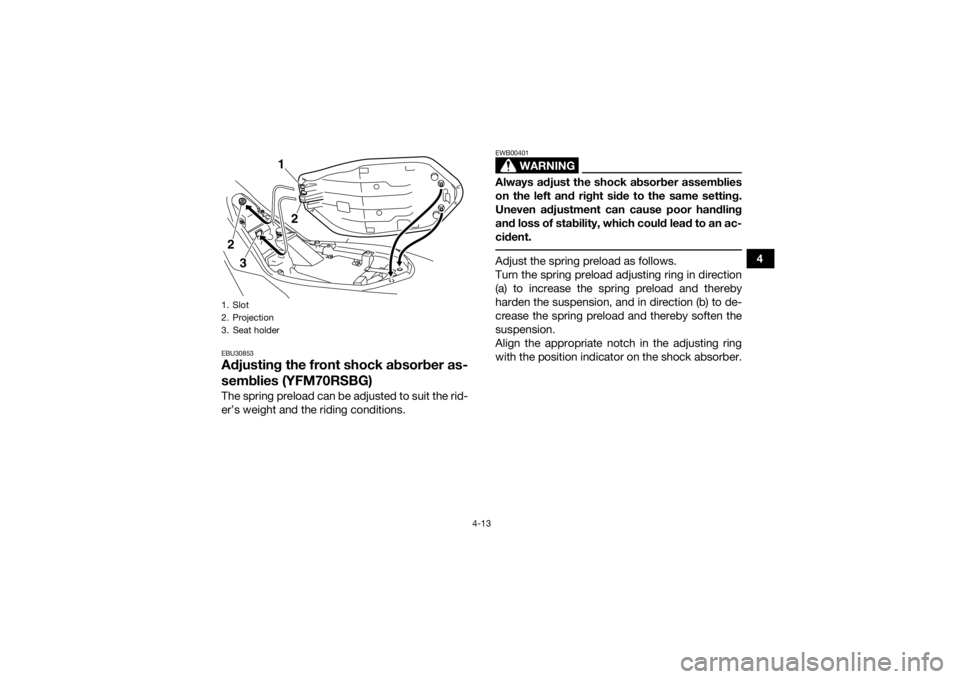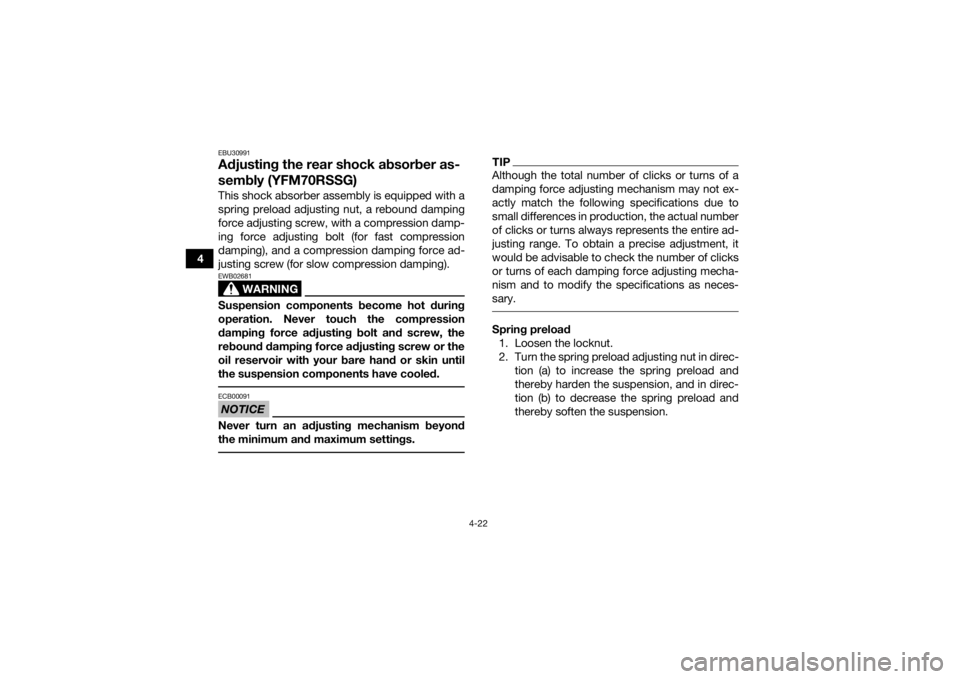suspension YAMAHA YFM700R 2016 Owners Manual
[x] Cancel search | Manufacturer: YAMAHA, Model Year: 2016, Model line: YFM700R, Model: YAMAHA YFM700R 2016Pages: 160, PDF Size: 3.75 MB
Page 10 of 160

Drive chain slack ....................................... 8-38
Lubricating the drive chain........................ 8-40
Checking and lubricating the cables......... 8-40
Checking and lubricating the brake and clutch levers ............................................ 8-41
Checking the shift pedal ........................... 8-41
Checking and lubricating the brake pedal ....................................................... 8-41
Checking the wheel hub bearings............. 8-42
Lubricating the swingarm pivots ............... 8-42
Lubricating the rear suspension relay arm and connecting arm pivoting points ....... 8-43
Lubricating the upper and lower arm pivots ...................................................... 8-44
Lubricating the steering shaft ................... 8-45
Battery....................................................... 8-45
Replacing a fuse ....................................... 8-48
Replacing a headlight bulb ....................... 8-50
Adjusting a headlight beam ...................... 8-51
Tail/brake light........................................... 8-52
Removing a wheel ..................................... 8-52
Installing a wheel....................................... 8-52
Troubleshooting ........................................ 8-53
Troubleshooting charts ............................. 8-54
CLEANING AND STORAGE ........................... 9-1 Cleaning ...................................................... 9-1 Storage ....................................................... 9-2
SPECIFICATIONS ........................................ 10-1
CONSUMER INFORMATION....................... 11-1 Identification numbers .............................. 11-1
INDEX .......................................................... 12-1
U2LS61E0.book Page 3 Friday, April 17, 2015 8:25 AM
Page 24 of 160

2-5
2ungrounded or broken wiring. Visually check
for broken wiring and leaking fuel. Leaking
fuel can be confirmed by the odor of gasoline.
4. Once immediate safety hazards are con- firmed not to exist, you may remove your hel-
met to more closely inspect your vehicle.
Check for external signs of wear, broken
parts, fluid leaks, cracks in the frame, sus-
pension damage, wheel damage, and so on.
Fuel, oil, and coolant usually give off a notice-
able odor.
5. If your vehicle will not restart or if it is unsafe to ride, then turn off all vehicle systems (en-
gine stop switch, main switch, and fuel cock),
and then signal or go for help.
Aftermarket Parts, Accessories, and Modifica-
tions
While you may find aftermarket products similar in
design and quality to genuine Yamaha accesso-
ries, recognize that some aftermarket accessories
or modifications are not suitable because of po-
tential safety hazards to you or others. Installing
aftermarket products or having other modifica-
tions performed to your vehicle that change any of
the vehicle’s design or operation characteristics
can put you and others at greater risk of serious injury or death. You are responsible for injuries re-
lated to changes in the vehicle. Keep the following
guidelines in mind, as well as those provided un-
der “Loading” when mounting accessories.
Never install accessories that would impair the
performance of your ATV. Carefully inspect the
accessory before using it to make sure that it
does not in any way reduce ground clearance,
limit suspension travel, steering travel or control
operation.
Accessories fitted to the ATV can create insta-
bility due to improper weight distribution.
Bulky or large accessories may seriously affect
the stability of the ATV.
Certain accessories can displace the operator
from his or her normal riding position. This im-
proper position limits the freedom of movement
of the operator and may limit control ability,
therefore, such accessories are not recom-
mended.
Use caution when adding electrical accesso-
ries. If electrical accessories exceed the capac-
ity of the ATV’s electrical system, an electric
failure could result, which could cause a dan-
gerous loss of lights or engine power.
U2LS61E0.book Page 5 Friday, April 17, 2015 8:25 AM
Page 41 of 160

4-13
4
EBU30853Adjusting the front shock absorber as-
semblies (YFM70RSBG)The spring preload can be adjusted to suit the rid-
er’s weight and the riding conditions.
WARNING
EWB00401Always adjust the shock absorber assemblies
on the left and right side to the same setting.
Uneven adjustment can cause poor handling
and loss of stability, which could lead to an ac-
cident. Adjust the spring preload as follows.
Turn the spring preload adjusting ring in direction
(a) to increase the spring preload and thereby
harden the suspension, and in direction (b) to de-
crease the spring preload and thereby soften the
suspension.
Align the appropriate notch in the adjusting ring
with the position indicator on the shock absorber.
1. Slot
2. Projection
3. Seat holder
1
2
3
2
U2LS61E0.book Page 13 Friday, April 17, 2015 8:25 AM
Page 43 of 160

4-15
4
Do not tamper with or attempt to open the
cylinder assemblies.
Do not subject the shock absorber assem-
blies to an open flame or other high heat
source. This may cause the unit to explode
due to excessive gas pressure.
Do not deform or damage the cylinders in
any way. Cylinder damage will result in poor
damping performance.
Do not dispose of a damaged or worn out
shock absorber assembly yourself. Take the
shock absorber assembly to a Yamaha deal-
er for any service.
EBU30981Adjusting the front shock absorber as-
semblies (YFM70RSSG)These shock absorber assemblies are equipped
with a spring preload adjusting nut, a rebound
damping force adjusting screw, with a compres-
sion damping force adjusting bolt (for fast com-
pression damping), and a compression damping
force adjusting screw (for slow compression
damping).
WARNING
EWB02492Suspension components become hot during
operation. Never touch the compression
damping force adjusting bolt and screw, the
rebound damping force adjusting screw or
the oil reservoir with your bare hand or skin
until suspension components have cooled.
Always adjust the shock absorber assem-
blies on the left and right side to the same
setting. Uneven adjustment can cause poor
handling and loss of stability, which could
lead to an accident. NOTICEECB00091Never turn an adjusting mechanism beyond
the minimum and maximum settings. TIPAlthough the total number of clicks or turns of a
damping force adjusting mechanism may not ex-
actly match the following specifications due to
small differences in production, the actual number
of clicks or turns always represents the entire ad-
justing range. To obtain a precise adjustment, it
U2LS61E0.book Page 15 Friday, April 17, 2015 8:25 AM
Page 44 of 160

4-16
4would be advisable to check the number of clicks
or turns of each damping force adjusting mecha-
nism and to modify the specifications as neces-
sary.
Spring preload
1. Loosen the locknut.
2. Turn the spring preload adjusting nut in direc- tion (a) to increase the spring preload and
thereby harden the suspension, and in direc-
tion (b) to decrease the spring preload and
thereby soften the suspension.
TIPA special wrench can be obtained at a Yamaha
dealer to make this adjustment.
The spring preload setting is determined by
measuring distance A, shown in the illustration.
The shorter distance A is, the higher the spring
preload; the longer distance A is, the lower the
spring preload. With each complete turn of the
adjusting nut, distance A is changed by 1.5 mm
(0.06 in).
1. Spring preload adjusting nut
2. Locknut
3. Special wrench
2
1
3
(a)
(b)
Spring preload setting:Minimum (soft):Distance A = 268.0 mm (10.55 in)
Standard: Distance A = 262.0 mm (10.31 in)
Maximum (hard): Distance A = 253.0 mm (9.96 in)
U2LS61E0.book Page 16 Friday, April 17, 2015 8:25 AM
Page 48 of 160

4-20
4
Do not dispose of a damaged or worn out
shock absorber assembly yourself. Take the
shock absorber assembly to a Yamaha deal-
er for any service.
EBU19047Adjusting the rear shock absorber as-
sembly (YFM70RSBG)The spring preload can be adjusted to suit the rid-
er’s weight and the riding conditions.NOTICEECB01091Never turn the adjusting mechanism beyond
the minimum and maximum settings. Adjust the spring preload as follows.
1. Loosen the locknut.
2. Turn the spring preload adjusting nut in direc- tion (a) to increase the spring preload and
thereby harden the suspension, and in direc-
tion (b) to decrease the spring preload and
thereby soften the suspension.
TIPA special wrench can be obtained at a Yamaha
dealer to make this adjustment.
The spring preload setting is determined by
measuring distance A, shown in the illustration.
The shorter distance A is, the higher the spring
preload; the longer distance A is, the lower the
spring preload. With each complete turn of the
adjusting nut, distance A is changed by 1.5 mm
(0.06 in). 1. Spring preload adjusting nut
2. Locknut
3. Special wrench
1
(b)
(a)
2
3
U2LS61E0.book Page 20 Friday, April 17, 2015 8:25 AM
Page 50 of 160

4-22
4
EBU30991Adjusting the rear shock absorber as-
sembly (YFM70RSSG)This shock absorber assembly is equipped with a
spring preload adjusting nut, a rebound damping
force adjusting screw, with a compression damp-
ing force adjusting bolt (for fast compression
damping), and a compression damping force ad-
justing screw (for slow compression damping).
WARNING
EWB02681Suspension components become hot during
operation. Never touch the compression
damping force adjusting bolt and screw, the
rebound damping force adjusting screw or the
oil reservoir with your bare hand or skin until
the suspension components have cooled. NOTICEECB00091Never turn an adjusting mechanism beyond
the minimum and maximum settings.
TIPAlthough the total number of clicks or turns of a
damping force adjusting mechanism may not ex-
actly match the following specifications due to
small differences in production, the actual number
of clicks or turns always represents the entire ad-
justing range. To obtain a precise adjustment, it
would be advisable to check the number of clicks
or turns of each damping force adjusting mecha-
nism and to modify the specifications as neces-
sary. Spring preload1. Loosen the locknut.
2. Turn the spring preload adjusting nut in direc- tion (a) to increase the spring preload and
thereby harden the suspension, and in direc-
tion (b) to decrease the spring preload and
thereby soften the suspension.
U2LS61E0.book Page 22 Friday, April 17, 2015 8:25 AM
Page 99 of 160

8-7
8
14*Drive chain roller • Check for wear and replace if necessary. √√√
15 *Chassis fasteners • Make sure that all nuts, bolts, and screws are
properly tightened. √√√√√
16 *Shock absorber as-
semblies • Check operation and correct if necessary.
• Check for oil leakage and replace if necessary.
√√√
17 *Rear suspension re-
lay arm and con-
necting arm
pivoting points • Check operation and correct if necessary.
• Lubricate with lithium-soap-based grease.
√√√√
18 *Steering shaft • Lubricate with lithium-soap-based grease. √√√
19 *Steering system • Check operation and repair or replace if dam-
aged.
• Check toe-in and adjust if necessary. √√√√√
20 *Engine mount • Check for cracks or other damage, and replace if
necessary. √√√
21 Engine oil • Change.
• Check ATV for oil leakage, and correct if neces-
sary. √ √√√
22 Engine oil filter ele-
ment • Replace.
√√√
NO. ITEM
CHECK OR MAINTENANCE
JOB INITIAL EVERY
Whichev- er comes first month136612
km (mi) 320
(200) 1300
(800) 2500
(1600) 2500
(1600) 5000
(3200)
hours 20 80 160 160 320U2LS61E0.book Page 7 Friday, April 17, 2015 8:25 AM
Page 135 of 160

8-43
8
EBU25005Lubricating the rear suspension relay
arm and connecting arm pivoting
pointsThe rear suspension relay arm and connecting
arm pivoting points must be lubricated at the inter-
vals specified in the periodic maintenance and lu-
brication chart.TIPFor parts equipped with a grease nipple, use a
grease gun. Recommended lubricant:Lithium-soap-based grease
1. Grease nipple
1. Grease nipple
1
1
U2LS61E0.book Page 43 Friday, April 17, 2015 8:25 AM
Page 154 of 160

10-4
10
Rim size:9 x 8.0ATFront brake:Type:
Disc brake
Operation: Right hand operation
Specified brake fluid: DOT 4Rear brake:Type:Disc brake
Operation: Right foot operation
Specified brake fluid:
DOT 4Front suspension:Type:Double wishbone
Spring/shock absorber type:
Coil spring/gas-oil damper
Wheel travel: 230 mm (9.1 in)Rear suspension:Type:
Swingarm (link suspension)
Spring/shock absorber type: Coil spring/gas-oil damper
Wheel travel: 256 mm (10.1 in)
Electrical system:Ignition system:TCI
Charging system:
AC magnetoBattery:Model:GT9B-4
Voltage, capacity:
12 V, 8.0 AhHeadlight:Bulb type:Krypton bulbBulb voltage, wattage × quantity:Headlight:
12 V, 30.0/30.0 W × 2
Tail/brake light: LED
Neutral indicator light:
LED
Fuel level warning light: LED
Reverse indicator light: LED
Coolant temperature warning light:
LED
Engine trouble warning light: LEDFuses:Main fuse:
30.0 A
U2LS61E0.book Page 4 Friday, April 17, 2015 8:25 AM